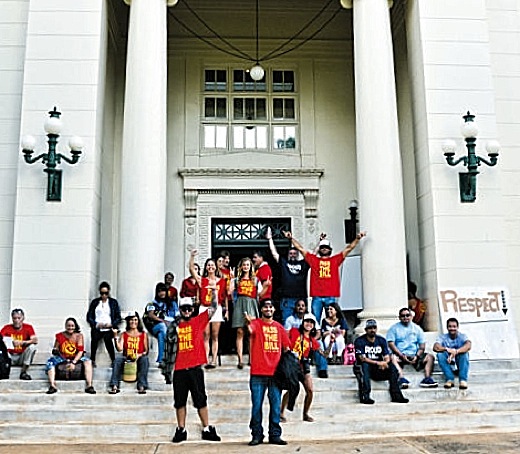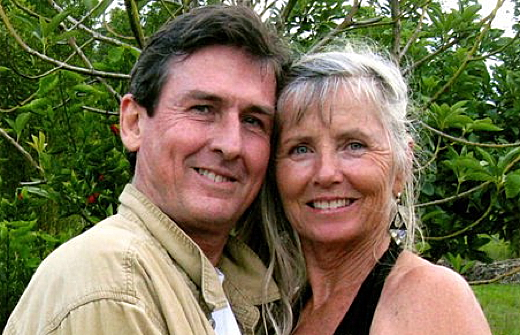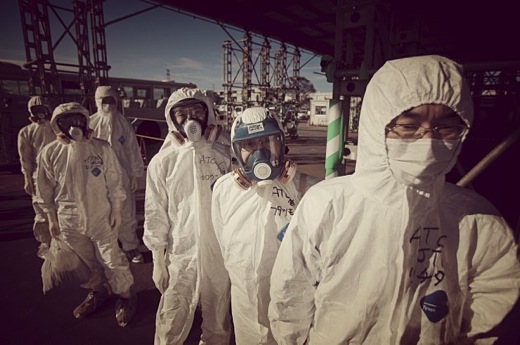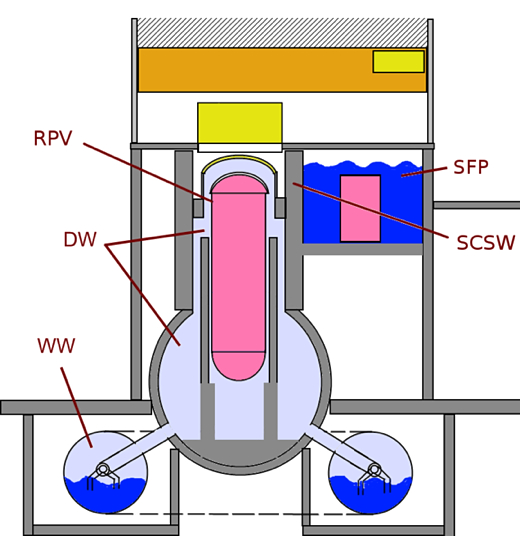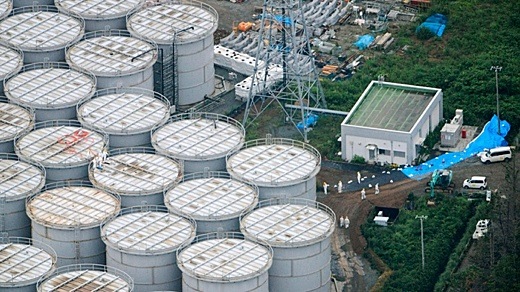SOURCE: Andy Parx (andyparx@yahoo.net)
SUBHEAD: Companies like Monsanto are often depicted as boogeymen who must be driven from Hawaii.
By Derrick DePledge on 29 September 2013 for the Star Advertiser -
(http://www.staradvertiser.com/s?action=login&f=y&id=225699861&id=225699861)

Image above: Destination of the Mana March at the Old County Building in Lihue Kauai in support of Bill 2492. From (https://www.facebook.com/surfriderkauai).
Kauai County Councilman Gary Hooser described the anti-GMO march in Lihue this month as the greatest show of grass-roots democracy in the island's history.
Thousands of people filled the streets to protest the spread of genetically modified organisms and pesticide use, the most visible expression of activism in a year when legislation to restrict GMOs gained traction on Kauai, in Hawaii County and at the state Legislature.
Gov. Neil Abercrombie has stepped into the fray with a promise that the state would set guidelines for biotechnology companies to voluntarily disclose the amount of restricted-use pesticides applied on Kauai and to agree to setbacks near schools and hospitals.
While the fear of GMOs might on the surface appear new — the latest outrage for environmentalists — the movement has been quietly building in Hawaii for a decade. It burst into public view this year because of a confluence of factors:
.
SUBHEAD: Companies like Monsanto are often depicted as boogeymen who must be driven from Hawaii.
By Derrick DePledge on 29 September 2013 for the Star Advertiser -
(http://www.staradvertiser.com/s?action=login&f=y&id=225699861&id=225699861)

Image above: Destination of the Mana March at the Old County Building in Lihue Kauai in support of Bill 2492. From (https://www.facebook.com/surfriderkauai).
Kauai County Councilman Gary Hooser described the anti-GMO march in Lihue this month as the greatest show of grass-roots democracy in the island's history.
Thousands of people filled the streets to protest the spread of genetically modified organisms and pesticide use, the most visible expression of activism in a year when legislation to restrict GMOs gained traction on Kauai, in Hawaii County and at the state Legislature.
Gov. Neil Abercrombie has stepped into the fray with a promise that the state would set guidelines for biotechnology companies to voluntarily disclose the amount of restricted-use pesticides applied on Kauai and to agree to setbacks near schools and hospitals.
While the fear of GMOs might on the surface appear new — the latest outrage for environmentalists — the movement has been quietly building in Hawaii for a decade. It burst into public view this year because of a confluence of factors:
- Newly elected county councilmembers on Kauai and in Hawaii County and a change of leadership in the state House have given anti-GMO activists allies in positions of power.
- Anti-GMO websites and social media platforms such as Facebook and Twitter have become incubators for grass-roots organizing, empowering activists with the belief that they are part of a national and global movement. The successful, social media-driven campaign that helped take down the Public Land Development Corp. this year also brought energy to the anti-GMO fight, which involves many of the same activists.
- Wealthy mainland philanthropists who underwrite environmental causes have donated significant amounts of money over the past several years to help Hawaii activists and educators raise awareness about GMOs, seed preservation and food sustainability.
"When we started organizing three or four years ago, we had a handful of people," said Walter Ritte, a Native Hawaiian activist on Molokai and board member for Hawai‘i SEED, a Koloa-based nonprofit aligned with GMO-Free Kaua‘i, GMO-Free Oahu, GMO-Free Maui and other leaders behind the movement. "And this year it just ballooned out. It just exploded."
Hawaii is an ideal stage for the GMO debate.
Monsanto, Syngenta, Dow AgroSciences, DuPont Pioneer and BASF own or lease 25,000 acres across the islands, about 5 percent of prime agricultural land, according to the Hawaii Crop Improvement Association. Seed, primarily corn, is a $250 million-a-year industry in Hawaii with about 2,000 jobs. The islands also have vocal environmental and progressive activists who have increasingly asserted their influence among the Democrats who dominate state politics.
The anti-GMO movement in Hawaii does not have the financial clout that the biotech giants can devote to public relations, lobbying and political campaign contributions, but wealthy mainland philanthropists, largely hidden from public view, have had an important hand in the groundwork.
The Ceres Trust, a Northfield, Minn.-based private foundation led by Kent Whealy, a seed preservation activist, and Judith Kern, a philanthropist, donated $145,490 to Hawai‘i SEED in 2011, federal tax filings show. The trust also gave $550,000 in 2011 and $650,000 in 2010 to the Center for Food Safety, a Washington, D.C.-based nonprofit that has fought the GMO industry.
Tax records for 2012 and 2013 are not yet public — and Whealy and Hawai‘i SEED did not respond to interview requests about philanthropy — but the Ceres Trust was listed as a sponsor for a speaking tour in Hawaii in January that featured Vandana Shiva, an environmental activist from India; Andrew Kimbrell, an environmental attorney and the executive director of the Center for Food Safety; and Ritte. The speaking tour, emceed by Nancy Redfeather, an organic farmer and educator, coincided with a march and rally against GMOs at the state Capitol on the opening day of the Legislature.
The Sacharuna Foundation, a Virginia-based private foundation started by Lavinia Currier, an heiress, filmmaker and philanthropist who lives in The Plains, Va., and has ranch property on Molokai, donated $68,750 to Hawai‘i SEED from 2005 to 2011. The foundation, tax filings show, also donated $257,400 to the Center for Food Safety from 2005 to 2010. Currier could not be reached for comment.
Ritte said the grant money has helped activists travel between the islands and with organizing. Hooser, who proposed a bill to regulate GMOs and pesticide use on Kauai, said he consulted with the Center for Food Safety on his legislation, along with local attorneys for Earthjustice and the Native Hawaiian Legal Corporation.
The Ceres Trust and the Sacharuna Foundation have also made sizable grants in Hawaii to promote seed preservation and food sustainability.
In 2011, tax filings show, the Ceres Trust gave $340,307 to E Kupaku ka ‘Aina — Hawaii Land Restoration Institute, a Wailuku-based effort to restore native ecosystems. Penny Levin, the institute's executive director who has spoken out against genetically modified taro, has been a leader in research to protect taro from pests and to preserve taro varieties.
The Sacharuna Foundation donated $53,000 from 2005 to 2011 to Ka Ohana o na Pua, Redfeather's Kealakekua-based nonprofit that does agricultural education and promotes school gardens. The Ceres Trust donated $40,000 in 2011 to The Kohala Center in Waimea for seed preservation. Redfeather, known for her organic Kawanui Farm, works with The Kohala Center.
"This is not anti-GMO education," Redfeather said in an interview. "This is agricultural education that is totally outside that realm."
Education on seed preservation and food sustainability has been overshadowed by some of the sharp-edged activism of the anti-GMO movement.
Using anti-GMO websites, Facebook pages and Twitter, activists have created an online echo chamber where biotech companies like Monsanto are often depicted as boogeymen who must be driven from Hawaii. Politicians, state and county administrators and agricultural researchers who do not fully share the activists' views are often portrayed as corrupt shills for the biotech industry.
Despite biotech's overwhelming financial advantage — and recent signs that the industry might be fighting back with similar guerrilla tactics — some biotech advocates say privately that the companies may have already lost the public-relations battle and that the debate in Hawaii has been defined by the activists.
The Public Land Development Corp., which was unanimously repealed this year by the Legislature, was derailed in part by a similar strain of activism. Environmentalists, Native Hawaiians and labor raised legitimate policy objections to the PLDC — a public-private partnership intended to develop underused public land — but it was the exaggerated, over-the-top rhetoric by activists that helped make the new agency politically toxic before it could launch a single project.
Anti-GMO activists, including many who have no background in science or agriculture, are making increasingly alarming and unverified claims about the health and environmental threats from GMO crops and pesticide use. Some who share the movement's goals worry privately that such rhetoric could undermine the movement's ability to reach the broader public, where issues like greater disclosure about GMO and pesticide use have appeal.
Ritte and other organizers, however, say the movement has already broken through and will keep building momentum if government and biotech companies resist greater disclosure.
"And the more they resist, the bigger the wave is going to get," he predicted. "I'm an organizer, you know. I'm thinking to myself, ‘Well, these guys are just playing right into our hands.' This thing is going to get bigger and bigger."
A DRIFT to the left in Democratic Party politics over the past several years has given anti-GMO activists an opening. Few Democrats, especially those with leadership aspirations, are willing to alienate the party's environmental and progressive wings by publicly dismissing or minimizing concerns about GMOs.
Many of the progressive Democrats who formed the coalition with minority Republicans behind new state House Speaker Joseph Souki in January support GMO restrictions. While there was some internal hesitation, the coalition named Rep. Jessica Wooley (D, Kahaluu-Ahuimanu-Kaneohe), a progressive who favors GMO labeling, as chairwoman of the House Agriculture Committee.
Wooley helped steer an admittedly flawed bill through the House that would impose labeling requirements on GMO produce sold in the state. The bill did not move through the Senate, but House leaders used the legislation as an example of progress under the new coalition.
"I think it's the public's persistent concern about their right to know," said Wooley, who plans to try again next session. "People aren't going to back off on this issue, I think, until they're given some basic information."
The failure of the GMO labeling bill at the Legislature helped ignite the issue at the county level, where anti-GMO activists have friends in newly elected councilmembers.
Hawaii County Councilwoman Margaret Wille, an attorney and community activist elected last November, said she is motivated by what she believes is arrogance by the biotech companies and acquiescence by the Legislature.
"I think some of us — Gary Hooser, myself — just said, ‘You may run over us but we're just not going to roll over,'" said Wille, who introduced one of two bills before the Hawaii County Council that would ban new GMO crops.
Hooser, a former state Senate majority leader and former director of the Office of Environmental Quality Control, was elected to the Kauai County Council last November and proposed the most far-reaching GMO and pesticide regulation bill.
The bill, which was amended by a council committee on Friday night by a 4-1 vote, now goes before the full council.
Hooser said the bill, if passed, could have statewide repercussions. But he said the legislation is in response to immediate concerns about biotech and pesticide exposure on Kauai.
"It really is about the local impacts," he said. "The urgency to deal with this issue does not exist in Hawaii Kai or Moiliili or McCully or Manoa or Kailua."
Hawaii is an ideal stage for the GMO debate.
Monsanto, Syngenta, Dow AgroSciences, DuPont Pioneer and BASF own or lease 25,000 acres across the islands, about 5 percent of prime agricultural land, according to the Hawaii Crop Improvement Association. Seed, primarily corn, is a $250 million-a-year industry in Hawaii with about 2,000 jobs. The islands also have vocal environmental and progressive activists who have increasingly asserted their influence among the Democrats who dominate state politics.
The anti-GMO movement in Hawaii does not have the financial clout that the biotech giants can devote to public relations, lobbying and political campaign contributions, but wealthy mainland philanthropists, largely hidden from public view, have had an important hand in the groundwork.
The Ceres Trust, a Northfield, Minn.-based private foundation led by Kent Whealy, a seed preservation activist, and Judith Kern, a philanthropist, donated $145,490 to Hawai‘i SEED in 2011, federal tax filings show. The trust also gave $550,000 in 2011 and $650,000 in 2010 to the Center for Food Safety, a Washington, D.C.-based nonprofit that has fought the GMO industry.
Tax records for 2012 and 2013 are not yet public — and Whealy and Hawai‘i SEED did not respond to interview requests about philanthropy — but the Ceres Trust was listed as a sponsor for a speaking tour in Hawaii in January that featured Vandana Shiva, an environmental activist from India; Andrew Kimbrell, an environmental attorney and the executive director of the Center for Food Safety; and Ritte. The speaking tour, emceed by Nancy Redfeather, an organic farmer and educator, coincided with a march and rally against GMOs at the state Capitol on the opening day of the Legislature.
The Sacharuna Foundation, a Virginia-based private foundation started by Lavinia Currier, an heiress, filmmaker and philanthropist who lives in The Plains, Va., and has ranch property on Molokai, donated $68,750 to Hawai‘i SEED from 2005 to 2011. The foundation, tax filings show, also donated $257,400 to the Center for Food Safety from 2005 to 2010. Currier could not be reached for comment.
Ritte said the grant money has helped activists travel between the islands and with organizing. Hooser, who proposed a bill to regulate GMOs and pesticide use on Kauai, said he consulted with the Center for Food Safety on his legislation, along with local attorneys for Earthjustice and the Native Hawaiian Legal Corporation.
The Ceres Trust and the Sacharuna Foundation have also made sizable grants in Hawaii to promote seed preservation and food sustainability.
In 2011, tax filings show, the Ceres Trust gave $340,307 to E Kupaku ka ‘Aina — Hawaii Land Restoration Institute, a Wailuku-based effort to restore native ecosystems. Penny Levin, the institute's executive director who has spoken out against genetically modified taro, has been a leader in research to protect taro from pests and to preserve taro varieties.
The Sacharuna Foundation donated $53,000 from 2005 to 2011 to Ka Ohana o na Pua, Redfeather's Kealakekua-based nonprofit that does agricultural education and promotes school gardens. The Ceres Trust donated $40,000 in 2011 to The Kohala Center in Waimea for seed preservation. Redfeather, known for her organic Kawanui Farm, works with The Kohala Center.
"This is not anti-GMO education," Redfeather said in an interview. "This is agricultural education that is totally outside that realm."
Education on seed preservation and food sustainability has been overshadowed by some of the sharp-edged activism of the anti-GMO movement.
Using anti-GMO websites, Facebook pages and Twitter, activists have created an online echo chamber where biotech companies like Monsanto are often depicted as boogeymen who must be driven from Hawaii. Politicians, state and county administrators and agricultural researchers who do not fully share the activists' views are often portrayed as corrupt shills for the biotech industry.
Despite biotech's overwhelming financial advantage — and recent signs that the industry might be fighting back with similar guerrilla tactics — some biotech advocates say privately that the companies may have already lost the public-relations battle and that the debate in Hawaii has been defined by the activists.
The Public Land Development Corp., which was unanimously repealed this year by the Legislature, was derailed in part by a similar strain of activism. Environmentalists, Native Hawaiians and labor raised legitimate policy objections to the PLDC — a public-private partnership intended to develop underused public land — but it was the exaggerated, over-the-top rhetoric by activists that helped make the new agency politically toxic before it could launch a single project.
Anti-GMO activists, including many who have no background in science or agriculture, are making increasingly alarming and unverified claims about the health and environmental threats from GMO crops and pesticide use. Some who share the movement's goals worry privately that such rhetoric could undermine the movement's ability to reach the broader public, where issues like greater disclosure about GMO and pesticide use have appeal.
Ritte and other organizers, however, say the movement has already broken through and will keep building momentum if government and biotech companies resist greater disclosure.
"And the more they resist, the bigger the wave is going to get," he predicted. "I'm an organizer, you know. I'm thinking to myself, ‘Well, these guys are just playing right into our hands.' This thing is going to get bigger and bigger."
A DRIFT to the left in Democratic Party politics over the past several years has given anti-GMO activists an opening. Few Democrats, especially those with leadership aspirations, are willing to alienate the party's environmental and progressive wings by publicly dismissing or minimizing concerns about GMOs.
Many of the progressive Democrats who formed the coalition with minority Republicans behind new state House Speaker Joseph Souki in January support GMO restrictions. While there was some internal hesitation, the coalition named Rep. Jessica Wooley (D, Kahaluu-Ahuimanu-Kaneohe), a progressive who favors GMO labeling, as chairwoman of the House Agriculture Committee.
Wooley helped steer an admittedly flawed bill through the House that would impose labeling requirements on GMO produce sold in the state. The bill did not move through the Senate, but House leaders used the legislation as an example of progress under the new coalition.
"I think it's the public's persistent concern about their right to know," said Wooley, who plans to try again next session. "People aren't going to back off on this issue, I think, until they're given some basic information."
The failure of the GMO labeling bill at the Legislature helped ignite the issue at the county level, where anti-GMO activists have friends in newly elected councilmembers.
Hawaii County Councilwoman Margaret Wille, an attorney and community activist elected last November, said she is motivated by what she believes is arrogance by the biotech companies and acquiescence by the Legislature.
"I think some of us — Gary Hooser, myself — just said, ‘You may run over us but we're just not going to roll over,'" said Wille, who introduced one of two bills before the Hawaii County Council that would ban new GMO crops.
Hooser, a former state Senate majority leader and former director of the Office of Environmental Quality Control, was elected to the Kauai County Council last November and proposed the most far-reaching GMO and pesticide regulation bill.
The bill, which was amended by a council committee on Friday night by a 4-1 vote, now goes before the full council.
Hooser said the bill, if passed, could have statewide repercussions. But he said the legislation is in response to immediate concerns about biotech and pesticide exposure on Kauai.
"It really is about the local impacts," he said. "The urgency to deal with this issue does not exist in Hawaii Kai or Moiliili or McCully or Manoa or Kailua."
.



